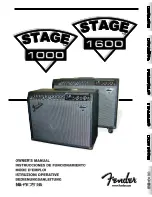
Operation Manual
I-Tech HD Series
Power Amplifiers
page 32
I-Tech HD Series
Power Amplifiers
Operation Manual
page 33
4.8.10 Crossover Filters
The Crossover section lets you use infinite impulse response (IIR) or
finite impulse response (FIR) filters for the crossover.
FIR advantages:
FIR has a longer processing latency but has less
phase artifacts compared to IIR. FIR allows for brickwall, 48dB/oct and
24dB/octave filters.
IIR advantages:
FIR has one processing block per channel; IIR has one
or more. For example, you can place an FIR at only one end of a channel,
but you can place an IIR at either end.
The amplifier contains two FIR blocks which can be used in various
configurations:
• 2x2 mode: One FIR filter per channel can be used.
• Bridge mono mode: Both FIR filters can be used.
• 1x2 mode: Two modes are available – Duplicate or Unique. In Duplicate
mode the same settings are used on both channels, allowing two FIR
filters per bandpass. In Unique mode the FIR filters are limited to one per
bandpass. However, if the High Pass of Channel 1 and Low Pass for
Channel 2 are set to identical slopes and frequencies, you can use FIR on
all the bandpasses. The logic for this operation is built into the software
controls. In addition, the Processing (FIR) latency sets the minimum
frequency that can be set for an FIR.
A polarity inverter button lets you change the polarity of each channel
independently.
4.8.11 LevelMax Suite
This is a suite consisting of a peak voltage limiter, average power limiter, clip limiter and thermal
transducer limiter. First you will set the mode to automatic or advanced:
• Automatic mode:
The software determines the best settings based on the signal characteristics.
You can modify only the RMS threshold, Speaker Thermal threshold and time constant. Everything
else is set automatically.
• Advanced mode:
You can modify the RMS threshold, Speaker Thermal threshold, time constant,
Peak threshold and Peak/RMS release.
Peak Voltage Limiter
This limits the peak voltage output of 4.8 the amplifier.
On:
Enables or disables this function. You’ll
set the parameters below:
• Threshold:
Sets the level, in absolute voltage, which the limiter will allow from the amplifier. The
range is from 12 V
pk
to 255 V
pk.
• Attack Time
: Sets the attack time of the limiter. The attack time is defined as the time it takes the
limiter to attenuate the output signal by 20 dB. The range is from 1 millisecond to 100 milliseconds.
The Instant setting attack time is instant (0 millisecond).
•
Release Time:
Sets the release time of the compressor. The release time is defined as the time it
takes the limiter to increase the output signal by 20 dB. The range is from 10 milliseconds to 10
seconds.
Average Power Limiter
This limits the long-term output power of the amplifier. You’ll set the parameters below:
• Threshold:
Sets the average power level, in watts, which the limiter will allow from the amplifier
channel. The range is from 10 watts to 10,000 watts. This level should be set to the connected
loudspeaker’s long-term power rating. Also you must enter the loudspeaker’s nomi nal impedance.
• Attack Time:
Sets the attack time of the limiter. The attack time is defined as the time it takes the
limiter to attenuate the output signal by 20 dB. The range is from 1 second to 30 seconds.
• Release Time:
Sets the release time of the compressor. The release time is defined as the time it
takes the limiter to increase the output signal by 20 dB. The range is from 1 second to 30 seconds.
Clip Eliminator:
This limiter monitors the clip events and attenuates the input signal to prevent
amplifier clipping. The attack and release times are preset to optimum rates. Only one parameter
controls this limiter. “Enable”
enables or disables this limiter.
A lookahead feature prevents overshoot of the limiters. These settings were developed with JBL to
protect the speakers from overvoltage.
Transducer Thermal Limiting
This limits the long-term output power of the amplifier to what the loudspeaker load can handle
without overheating and going into thermal compression. You can set the thermal level at which the
thermal limiter engages, the thermal response time and thermal voltage. Your loudspeaker
manufacturer might be able to provide this information. Meters show the amplifier output level in
dBFS; and peak, rms, and total gain reduction.
4.8.12 Front Panel Security
Here you can choose which amplifier LCD
screens to lock so they can’t be changed.
4 Advanced Operation
4 Advanced Operation
Each audio channel has three separate places where filters can be placed in the
system: input EQ (16 filters), Crossover, and Output EQ. Up to 24 filters per
channel are available, plus crossover filters and 4 filters for the signal
generator. Each filter has up to +/-24dB of gain. The following filters are
available:
•
Lowpass: Bessel 2-4, Butterworth1-4, and Linkwitz-Riley 8
•
Highpass: Bessel 2-4, Butterworth1-4, and Linkwitz-Riley 8
•
Lowshelf: Low-frequency shelving EQ
•
Highshelf: High-frequency shelving EQ
•
Lowpass EQ: Variable bandwidth, can be expressed as Q (0.100 to 35) or
Octaves (0.041 to 6.672)
•
Highpass EQ: Variable Q from 0.1 to 25
•
Parametric EQ: Variable Q form 0.1 to 35
Содержание I-T12000 HD
Страница 31: ......















































